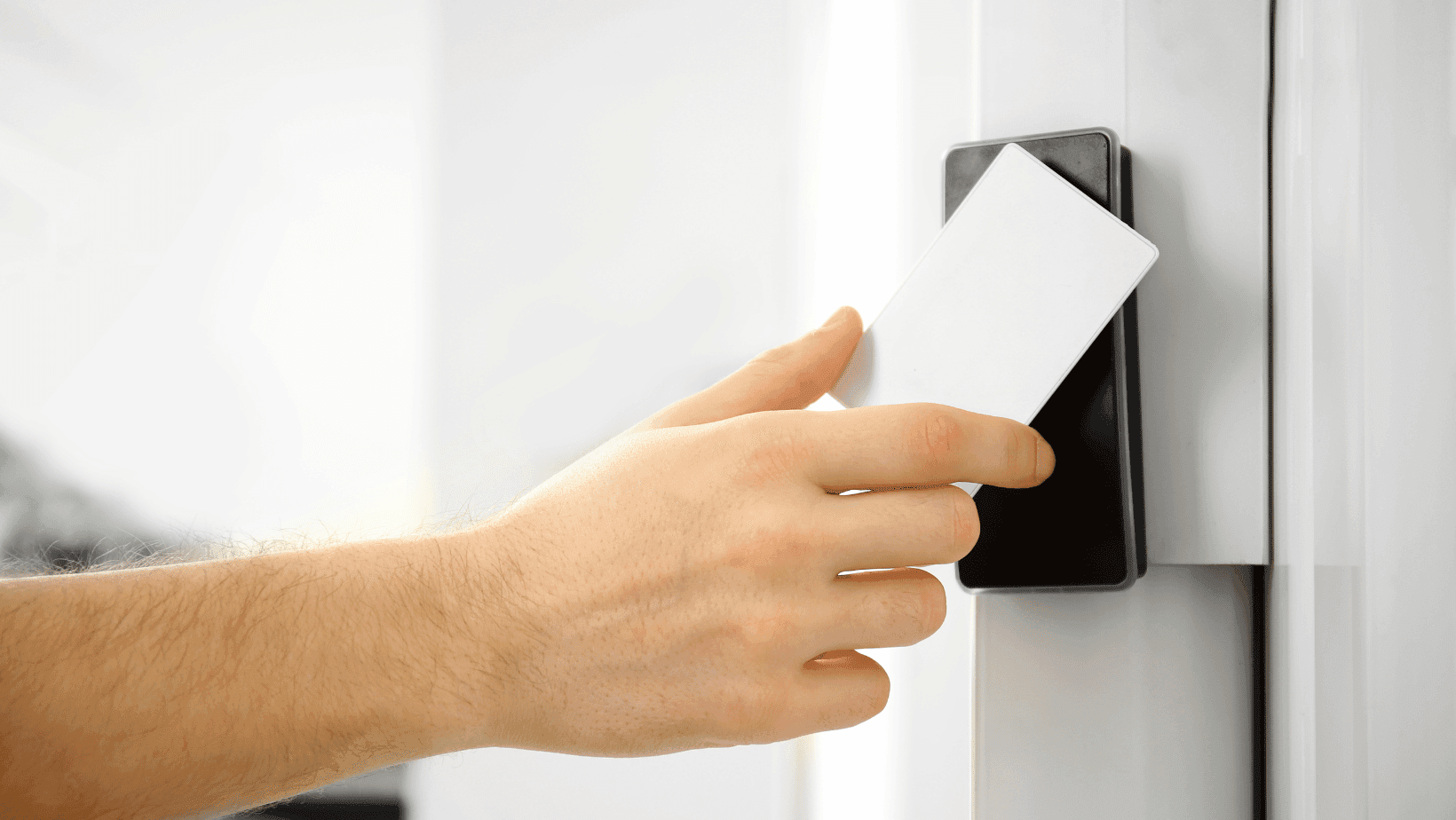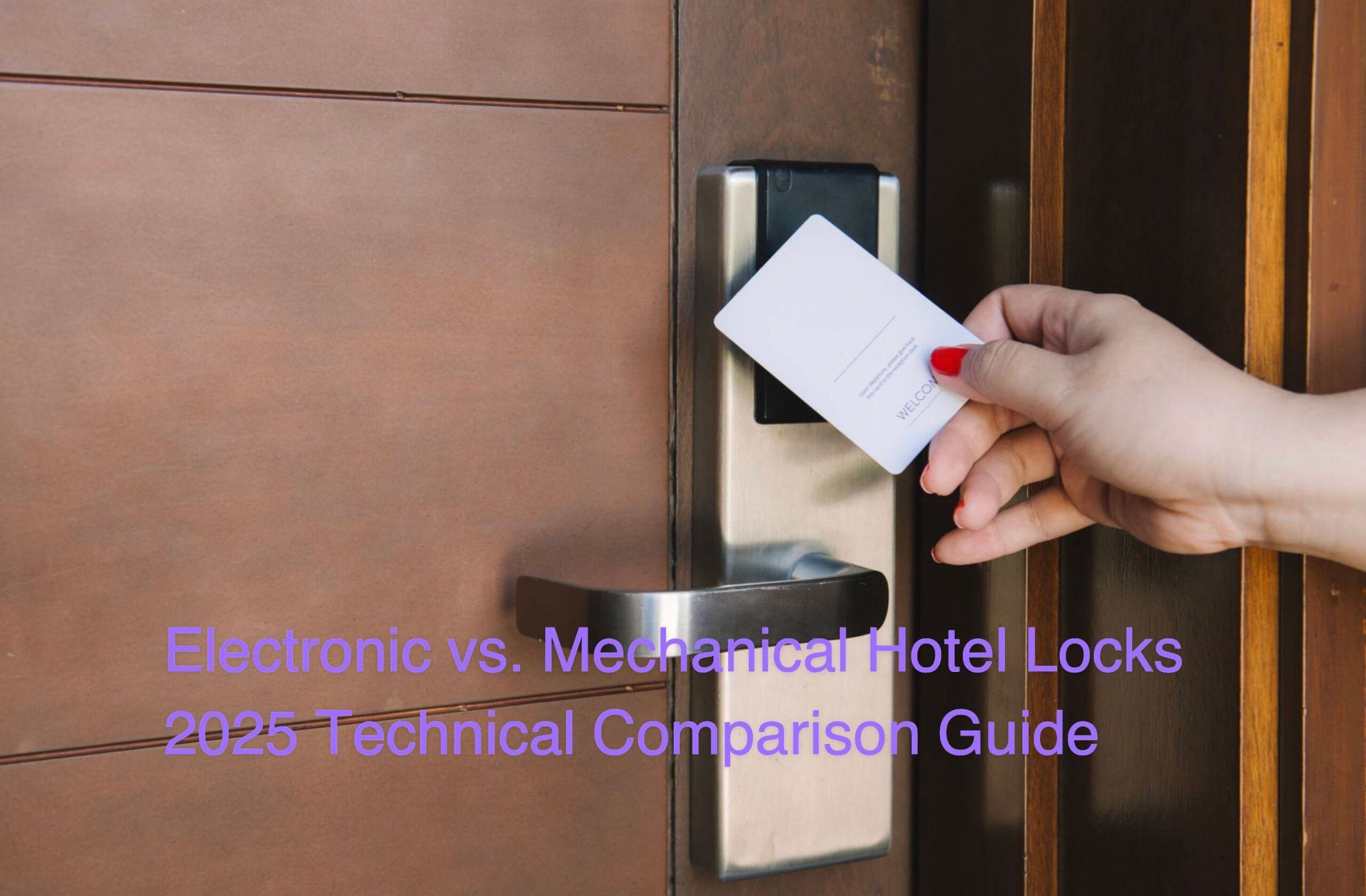In today’s hospitality industry, Radio Frequency Identification (RFID) technology has revolutionized hotel door lock systems, offering unprecedented levels of security, convenience, and operational efficiency. As we move through 2025, understanding the technical specifications of these systems—particularly frequency standards and read range optimization—is crucial for hotel security managers, procurement specialists, and technology officers seeking to implement or upgrade their access control systems.
Understanding RFID Technology in Hotel Security Systems
RFID hotel lock systems utilize electromagnetic fields to automatically identify and track tags attached to objects, in this case, key cards or mobile credentials. Unlike traditional magnetic stripe cards that require physical contact with readers, RFID technology enables contactless communication between credentials and lock mechanisms.

These systems consist of three primary components:
- RFID Tags/Cards: Contain microchips and antennas that store and transmit guest identification data
- RFID Readers: Installed in door locks to emit radio waves that power and communicate with tags
- Management Software: Controls access permissions, monitors activity, and integrates with property management systems
According to a 2024 hotel security survey by the American Hotel & Lodging Association, 87% of upscale properties now utilize RFID technology in their locking systems, with implementation growing at 13.1% annually across all hotel segments.
RFID Frequency Standards in Hotel Applications
The frequency at which an RFID system operates fundamentally determines its performance characteristics, including read range, data transfer rates, and resistance to environmental interference. For hotel applications, three primary frequency bands are relevant:
Low Frequency (LF) – 125-134 kHz
Low Frequency RFID operates between 125-134 kHz and offers the shortest read range of all RFID technologies.
Key characteristics:
- Read range: Typically less than 10 cm
- Data speed: Relatively slow (less than 1 kbit/s)
- Interference resistance: Excellent performance near metal and liquids
- Security level: Good basic security but limited encryption capabilities
- Application in hotels: Primarily used in legacy systems or high-security areas
While LF systems have largely been superseded in hotel applications, they remain relevant in environments with significant electromagnetic interference or where extremely short read ranges are desired for security purposes.
High Frequency (HF) – 13.56 MHz
High Frequency RFID operating at 13.56 MHz has become the industry standard for hotel locking systems in 2025.
Key characteristics:
- Read range: 10 cm to 1 meter (typically optimized to 1-5 cm in hotel locks)
- Data speed: Medium (typically 25 kbit/s)
- Interference resistance: Good performance near metal with proper tuning
- Security level: Excellent encryption capabilities
- Application in hotels: Mainstream solution for guest rooms and access control
- Compliance: ISO 14443A standard widely adopted globally
HF systems offer an ideal balance of security and convenience for hotel applications. The controlled read range prevents accidental activations while still providing the convenience of contactless operation. These systems also support Near Field Communication (NFC), enabling mobile key functionality on smartphones.
Ultra-High Frequency (UHF) – 860-960 MHz
Ultra-High Frequency RFID systems operate in the 860-960 MHz range and offer the longest potential read ranges.
Key characteristics:
- Read range: Up to 100 meters in ideal conditions
- Data speed: Fast (up to 640 kbit/s)
- Interference resistance: More susceptible to environmental factors
- Security level: Moderate to high depending on implementation
- Application in hotels: Primarily used for perimeter access, parking garages, or asset tracking
While UHF’s long read range makes it less common for individual room locks, innovative hotels are beginning to use it for seamless guest experiences, such as automatic recognition upon arrival or contactless access to amenities.
Frequency Comparison for Hotel Applications
| Frequency Band | Typical Read Range | Best Hotel Applications | Security Level | Interference Resistance | Mobile Key Compatibility |
|---|---|---|---|---|---|
| LF (125 kHz) | ≤10 cm | High-security areas, legacy systems | Good | Excellent | Limited |
| HF (13.56 MHz) | 1-5 cm (optimized) | Guest rooms, amenities, standard access | Excellent | Good | Full NFC support |
| UHF (860-960 MHz) | Up to 100m | Perimeter access, parking, asset tracking | Moderate to High | Fair | Limited |
Factors Affecting RFID Read Range in Hotel Environments
The read range of an RFID hotel lock system is influenced by numerous factors beyond just the operating frequency. Understanding these elements is crucial for optimizing system performance while maintaining security.
Technical Factors Impacting Read Range
1. Reader Power and Sensitivity
The power output of the reader directly affects how far it can communicate with RFID tags. In hotel lock systems, reader power is deliberately calibrated to achieve optimal read ranges:
- Higher power: Increases convenience but may introduce security vulnerabilities
- Lower power: Enhances security but may frustrate guests if cards must be held extremely close
As noted in the Microchip Technology report on RFID systems, “Available RF power rapidly falls off with the tag-to-reader distance, proportional to the inverse sixth-power of the distance between them.”
2. Antenna Design and Orientation
The design, size, and orientation of both the reader and tag antennas significantly impact read range:
- Reader antenna design: Larger antennas typically provide better range but may not fit aesthetically in hotel door lock designs
- Tag antenna design: Larger antennas in key cards improve range but must balance with practical card size
- Orientation sensitivity: Misalignment between reader and tag antennas can dramatically reduce read range
3. Quality Factor (Q) and Tuning
The quality factor (Q) of the RFID circuit affects both read range and bandwidth:
- Higher Q values: Provide longer read ranges but narrower bandwidth (more sensitive to detuning)
- Lower Q values: Offer more consistent performance across various environments but shorter maximum range
4. Card/Tag Power Consumption
For passive RFID systems (most common in hotels), tags derive power from the reader’s electromagnetic field:
- Higher chip sensitivity: Requires less power to activate, resulting in longer read ranges
- Additional features: Security encryption and other advanced features increase power requirements, potentially reducing range
Environmental Factors Affecting Performance
Hotel environments present unique challenges for RFID systems due to various materials and interference sources:
1. Door Materials and Mounting Surfaces
Door composition significantly impacts RFID performance:
- Metal doors: Can cause detuning and signal reflection, reducing read range by up to 40%
- Wooden doors: Generally allow for optimal performance
- Glass doors: May require specialized tuning due to dielectric properties
2. Electromagnetic Interference
Hotels contain numerous potential sources of electromagnetic interference:
- Wi-Fi networks: Operating at 2.4 GHz or 5 GHz, these can affect UHF systems
- Electronic equipment: TVs, HVAC systems, and other devices may generate interference
- Neighboring RFID systems: Other nearby RFID readers can cause signal conflicts
3. Environmental Conditions
Physical environmental factors can impact performance:
- Temperature fluctuations: Extreme temperatures can affect both reader and tag performance
- Humidity levels: High humidity can impact the dielectric properties of materials, affecting tuning
- Weathering (for exterior locks): UV exposure and precipitation can degrade outdoor RFID components
Optimizing Read Range for Hotel RFID Lock Systems
Successfully implementing RFID technology in hotel lock systems requires carefully balancing security requirements with guest convenience. Here are key strategies for optimizing read range while maintaining system integrity.
Hardware Optimization Techniques
1. Adaptive Power Management
Implementing adaptive power management in RFID readers allows for intelligent adjustment based on environmental conditions:
- Dynamic power scaling: Automatically increases power when interference is detected
- Time-based power profiles: Adjusts power levels based on time of day (higher during busy check-in periods)
- Zoned power settings: Different power profiles for different areas (higher for exterior doors, lower for guest rooms)
2. Advanced Antenna Design
Utilizing specialized antenna configurations can significantly improve performance:
- Directional antennas: Focus the RF field toward the expected card presentation area
- Multiple antenna arrays: Provide better coverage regardless of card orientation
- Shielded designs: Reduce interference from underlying door materials
According to Be-Tech’s engineering team, their RFID hotel lock system incorporates “balanced antenna design that achieves consistent read ranges of 1-5 cm while minimizing power consumption for extended battery life.”
3. Frequency Optimization
Fine-tuning the exact operating frequency within the allowable band:
- Frequency hopping: Some advanced systems can shift frequencies to avoid interference
- Regional optimization: Adjusting to the specific frequency allowances in different countries
- Environmental compensation: Automatically adjusting frequency based on detected material properties
Software and Configuration Approaches
1. Signal Processing Algorithms
Modern RFID hotel locks employ sophisticated signal processing to maximize read range while maintaining security:
- Digital filtering: Reduces noise and improves signal recognition
- Pattern recognition: Identifies and compensates for common interference patterns
- Adaptive threshold adjustment: Dynamically adjusts the signal threshold for tag recognition
2. Read Sensitivity Configuration
Tailoring the sensitivity settings based on specific deployment requirements:
- Custom sensitivity profiles: Different settings for different areas (higher for amenities, lower for guest rooms)
- Time-based adjustments: Reduced sensitivity during quiet hours
- Guest preference options: Some systems allow guests to select convenience or privacy modes
3. Integration with Mobile Key Systems
Modern hotel lock systems increasingly incorporate multiple credential technologies:
- Dual-technology readers: Support both physical RFID cards and mobile credentials
- BLE/NFC hybridization: Use optimal technology based on guest preference
- Proximity wake-up: RFID used to trigger wake-up of low-power BLE systems
Balancing Security and Convenience
The fundamental challenge in optimizing RFID read range lies in balancing security concerns with guest convenience:
1. Security Considerations
- Eavesdropping risk: Longer read ranges increase the risk of credential data being intercepted
- Relay attacks: Extended ranges make systems more vulnerable to sophisticated relay attacks
- Unintended access: Excessive range could potentially activate locks from adjacent rooms
2. Convenience Factors
- Accessibility compliance: Systems must accommodate guests with mobility challenges
- User experience: Frustration with inconsistent reads leads to poor guest satisfaction
- Operational efficiency: Staff requires reliable, quick access for housekeeping and maintenance
3. Optimal Range Determination
Research conducted by hospitality security consultants indicates the ideal read range for hotel door locks is typically:
- Guest room doors: 1-5 cm (requiring intentional presentation but not precise alignment)
- Amenity areas: 5-10 cm (slightly more convenient for high-traffic areas)
- Exterior access points: 10-15 cm (accommodating gloves or bulky items carried by guests)
Best Practices for RFID Hotel Lock Implementation (2025 Standards)
As we move through 2025, the hospitality industry continues to refine best practices for RFID lock implementations. Here are current recommendations for maximizing performance and security:
Security Considerations
1. Encryption and Authentication
Modern RFID hotel systems should implement:
- AES-256 encryption: Industry-standard encryption for credential data
- Dynamic key rotation: Regularly changing encryption keys to prevent compromise
- Multi-factor authentication: Combining RFID with PIN codes or biometrics for high-security areas
2. Anti-Tamper Technologies
Physical security measures that enhance RFID lock integrity:
- Tamper-evident housings: Visible indicators if lock hardware has been compromised
- Accelerometer integration: Detects and alerts to physical attacks on the lock
- Audit trail capabilities: Comprehensive logging of all access attempts, including failed reads or unusual patterns
3. Regulatory Compliance
Ensuring systems meet evolving standards:
- FCC compliance: Adherence to radio frequency regulations (varies by country)
- PCI DSS requirements: For systems integrated with payment processing
- GDPR and data privacy: Proper handling of guest credentials and access data
Integration with Hotel Management Systems
1. Property Management System (PMS) Integration
Seamless connection between locks and central hotel systems:
- Real-time key issuance: Instant programming of credentials upon check-in
- Automatic expiration: Keys that deactivate precisely at checkout time
- Room reassignment handling: Proper management of credentials during room changes
2. Mobile Access Integration
Supporting the growing trend of smartphone-based access:
- Cross-platform support: Solutions working with both iOS and Android devices
- Offline functionality: Access working even when guest phones lack internet connectivity
- Secure credential delivery: Encrypted channels for delivering mobile keys
3. Energy Management Integration
Using RFID technology to improve sustainability:
- Occupancy detection: RFID readers that communicate with energy management systems
- Selective power activation: Only powering necessary room systems when guests are present
- Usage pattern analysis: Data collection to optimize energy consumption
Installation and Maintenance Best Practices
1. Professional Installation Considerations
- RF site surveys: Pre-installation testing to identify interference sources
- Door material compensation: Adjustments based on specific door construction
- Proper antenna placement: Positioning to maximize read reliability
2. Regular System Testing
- Scheduled performance audits: Regular testing of read ranges and success rates
- Battery management: Proactive replacement before performance degradation
- Firmware updates: Keeping system current with latest security patches
3. Staff Training Requirements
- Troubleshooting protocols: Training staff to address common RFID issues
- Security awareness: Educating team on security vulnerabilities
- Guest assistance procedures: Properly helping guests who experience difficulties
Future Trends in RFID Hotel Lock Technology (2025 and Beyond)
The hotel security landscape continues to evolve rapidly. Here are key trends shaping the future of RFID hotel locks:
1. Biometric Integration
- Fingerprint + RFID hybrid systems: Using multiple factors for enhanced security
- Facial recognition complementing RFID: Contactless multi-factor authentication
- Behavioral biometrics: Systems that learn guest patterns for anomaly detection
2. Enhanced Connectivity
- Mesh network capabilities: Locks that communicate with each other to extend network coverage
- IoT integration: Connection with broader hotel systems for comprehensive guest experiences
- 5G connectivity: Direct cellular connections for real-time monitoring and updates
3. Advanced Materials and Designs
- Energy harvesting: Locks that supplement battery power with energy from guest interactions
- Miniaturization: Smaller, less obtrusive hardware that maintains security performance
- Antimicrobial surfaces: Materials that reduce pathogen transmission in high-touch areas
Be-Tech’s latest hotel lock innovations incorporate “intelligent read range management that adapts to guest behavior patterns, optimizing convenience while maintaining strict security protocols.”
Conclusion: Balancing Technology and Guest Experience
The optimization of RFID frequency and read range in hotel locks represents the delicate balance between technical performance, security requirements, and guest experience. As we’ve explored, numerous factors influence this balance, from the physical characteristics of radio waves to the practical realities of hotel operations.
For hotel operators and security professionals implementing RFID technology, the key takeaways include:
- Frequency selection is crucial: HF (13.56 MHz) systems currently offer the optimal balance for most hotel applications, though specific use cases may benefit from LF or UHF implementations.
- Read range optimization is multifaceted: Hardware design, software configuration, and environmental factors all play important roles in determining effective read range.
- Security and convenience must be balanced: The ideal system provides reliable, consistent access for legitimate users while protecting against unauthorized access.
- Integration capabilities matter: Modern RFID systems should seamlessly connect with PMS, mobile, and energy management systems.
- Future-proofing requires adaptability: Systems should be upgradable to accommodate emerging technologies and evolving security standards.
By carefully considering these factors and working with reputable providers like Be-Tech Lock, hotels can implement RFID locking systems that enhance security, improve operational efficiency, and deliver the seamless experience guests expect in 2025 and beyond.







